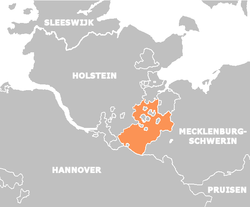
Back دوقية ساكسونيا لاونبورغ Arabic Херцогство Саксония-Лауенбург Bulgarian Sachsen-Lauenburg Breton Sasko-lauenburské vévodství Czech Sachsen-Lauenburg Danish Herzogtum Sachsen-Lauenburg German Δουκάτο της Σαξονίας-Λάουενμπουργκ Greek Saksio-Lauenburg Esperanto Ducado de Sajonia-Lauenburgo Spanish Saksi-Lauenburg Estonian
Duchy of Saxe-Lauenburg Herzogtum Sachsen-Lauenburg (German) | |||||||||
|---|---|---|---|---|---|---|---|---|---|
| |||||||||
Coat of arms (1507–1671)
| |||||||||
| Attributed arms of the Saxe-Lauenburg The Saxon Steed[Note 1] | |||||||||
 The Duchy of Saxe-Lauenburg in 1848 (map in Dutch) | |||||||||
| Status |
| ||||||||
| Capital | Lauenburg/Elbe Ratzeburg (from 1619) | ||||||||
| Religion | Earlier: Roman Catholic Later: Lutheran | ||||||||
| Government | Duchy | ||||||||
| Duke | |||||||||
• 1296–1303 | Eric I (first) | ||||||||
• 1865–1876 | William (last) | ||||||||
| Historical era | Middle Ages | ||||||||
• Partitioned from Duchy of Saxony | 1296 | ||||||||
• Partitioned into Saxe-Mölln-Bergedorf and Saxe-Ratzeburg | 1303–1401 | ||||||||
• Personal union with Lüneburg-Celle | 1689–1705 | ||||||||
• Personal union with Hanover | 1705–1803 | ||||||||
• Dissolved during Napoleonic Wars | 1803–1814 | ||||||||
• Personal union with Denmark | 1814–1864 | ||||||||
• Personal union with Prussia | 1865–1876 | ||||||||
• Merged into Prussia | 1876 | ||||||||
| |||||||||
| Today part of | |||||||||

The Duchy of Saxe-Lauenburg (German: Herzogtum Sachsen-Lauenburg, called Niedersachsen (Lower Saxony) between the 14th and 17th centuries; Danish: Hertugdømmet Sachsen-Lauenborg), was a reichsfrei duchy that existed from 1296 to 1803 and again from 1814 to 1876 in the extreme southeast region of what is now Schleswig-Holstein. Its territorial center was in the modern district of Herzogtum Lauenburg and originally its eponymous capital was Lauenburg upon Elbe, though the capital moved to Ratzeburg in 1619.
Cite error: There are <ref group=Note> tags on this page, but the references will not show without a {{reflist|group=Note}} template (see the help page).


